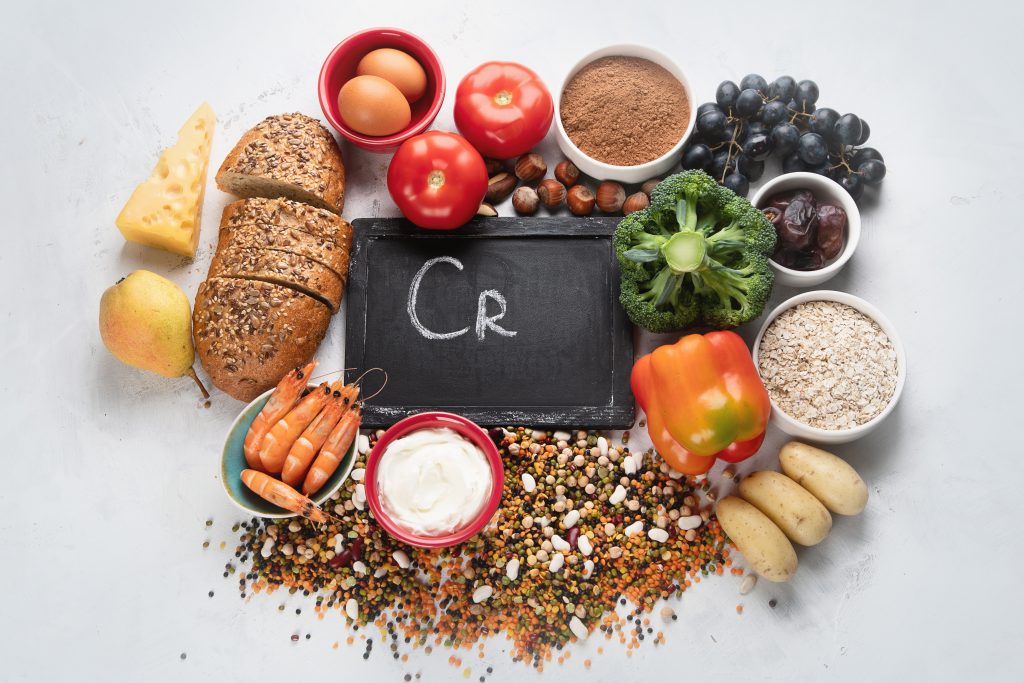Mastering Chromium
InterClinical eNews June 2020, Issue 107

Characteristics of chromium
Chromium is the eighth largest classical element in the earth’s crust.1 The human body’s total content is approximately 6 milligrams. 8 It is widely distributed in the atmosphere, soil, water, animals and plants in the form of chromite. Chromium is a biologically active element that is at its highest in body tissue at birth and declines with age. 8
The first major research on chromium in the early 1960s concluded that chromium was an essential element for humans. As recently as 1989 the Food and Nutrition Board recognized that ‘trivalent chromium is required to maintain normal glucose metabolism in laboratory animals; it acts as a cofactor for insulin.’2
The definition of an essential element is when ‘a deficiency causes interference with growth, development, or maturation, such that procreation is prevented’. A dietary deficiency of the element has to consistently impair a biochemical or physiological function that could be prevented or reversed by nutritional or physiological intakes of the element. With this definition in mind, the essentiality of chromium has been disputed.2 However, the controversy over chromium’s essentiality does not preclude it being considered a bioactive element with beneficial effects when supplemented. Studies have shown that chromium supplements in chemical forms such as picolinate, proprionate, niacinate, histadinate, and malate in therapeutic amounts can consistently alleviate insulin resistance and diabetes and associated changes in carbohydrate and lipid metabolism. 2 Many studies report that chromium is decreased in diabetes patients, and insulin resistance is improved by the supplementation of chromium. 10
Chromium’s role
In the 60 years since chromium’s role in blood sugar regulation was suggested, little progress has been made in establishing its nutritional requirement and biochemistry. In the 1980’s a unique chromium-binding oligopeptide called chromodulin was isolated and characterized, with the ability to potentiate the effects of insulin, without changing its concentration.3 Apochromodulin (the predominant form in vivo) can accept chromic ions from other biological molecules such as transferrin, to form holochromodulin.2 The newly generated holochromodulin (i.e., Cr4-chromodulin) can then bind to the insulin-stimulated insulin receptor, helping to maintain its active conformation and amplifying the receptors kinase activity.3 Tyrosine kinases are important mediators of the signaling cascade, determining key roles in diverse biological processes like growth, differentiation, metabolism and apoptosis in response to external and internal stimuli.7
Chromium affects many processes of the insulin signaling pathway.2 In response to increases in blood sugar levels, insulin is released rapidly into the bloodstream. Increases in plasma insulin concentrations have been found to result in a movement of chromium from the blood to insulin-dependent cells. This transfer is likely mediated by the metal transport protein transferrin.3
Chromium was also found to alter plasma membrane cholesterol. It is suggested that it does this through affecting AMP-activated protein kinase. Chromium upregulates mRNA levels of the insulin receptor GLUT4, however this may be occurring through the amplification of insulin, which also increases mRNA. Chromium might have biological activity through regulating gene expression in some manner, since it was found to up-regulate genes encoding proteins involved in glycolysis in a study on obese mice.2
Chromium and diet

The daily requirement for chromium is about one microgram per day. However, an individual should consume between 30 and 200 micrograms to fulfill that requirement due to its poor absorption. 8 Chromium deficiency is a widespread problem. Many individuals such as athletes, diabetics, pregnant women, and the elderly are especially at risk of chromium deficiency. This can lead to impaired insulin function, inhibition of protein synthesis and energy production and ultimately to type 2 diabetes and cardiovascular dysfunction. Chromium deficient diets are characterised by large quantities of refined foods, especially simple sugars. This exacerbates the problem, since these foods are not only low in chromium but they also induce enhanced excretion of chromium in the urine.4
Several animal experiments have also demonstrated that high sucrose, chromium deficient diets potentially cause severe atherosclerosis. Loss of chromium occurs during long periods of stress such as pregnancy, infection, physical trauma, and strenuous exercise. Many studies have shown a strong relationship between chromium deficiency, high blood insulin and elevated cholesterol levels.4
The presence of amino acids, phytates in high amounts, oxalates and ascorbic acid in the diet alter chromium uptake. However, low levels of phytates appear to have little effect on absorption, and the overall effect of all these on absorption is not large.5
Bioavailability of Chromium
After absorption in the gastrointestinal tract, chromium is transported to cells bound to the plasma protein transferrin. Insulin initiates chromium transport into the cells where it is bound to the oligopeptide apochromodulin. Apochromodulin, combines with four chromium molecules to form the oligopeptide chromodulin. Chromodulin is important in amplifying the insulin signalling effect, increasing tyrosine kinase activity and forms part of the intracellular portion of the insulin receptor.4
Chromium in food is absorbed by passive diffusion in very low amounts and most is excreted unabsorbed in the faeces. Increased absorption generally results in increased excretion of chromium. Over 80% of chromium in the bloodstream is bound to transferrin which transfers chromium to tissues. Other molecules are also involved in the movement of chromium and one of these is chromodulin.2
Dietary ingestion of high amounts of various chromium supplements has not been found to induce any marked signs of toxicity. In fact no toxic effect were seen in rats fed 100,000 ug Cr/kg diet as chromium picolinate for 24 weeks.2
Some studies have found that urinary chromium loss and chromium concentrations in the body are functions of absorption. Increases in blood insulin concentrations (including those stemming from rises in blood glucose concentration) result in increased urinary Cr loss.6
Vitamins such as niacin and ascorbic acid act synergistically in the absorption of chromium. And minerals such as zinc, iron, manganese, copper and calcium reduce the body’s absorption of chromium by reacting with it to form complexes.1
Determining Chromium status
Determining chromium status is important, since it has a critical role in blood sugar regulation. Hair is an easily obtained biopsy material. During its growth it is exposed to blood, lymph and extracellular fluids. Within it, is contained the minerals incorporated during its development. The use of hair to determine chromium levels has an advantage over other tissues. Urine measures the component that is absorbed and excreted, and blood measures the component that is temporarily in circulation before it is sequestered or excreted. The chromium content found in the hair is apparently related to and reflective of chromium nutritional status. An increase in hair tissue chromium levels have been reported in patients receiving chromium supplementation. Hair Tissue Mineral Analysis is a useful tool for evaluating chromium nutrition and tissue storage. 11
InterClinical Comment
Chromium is a mineral that humans require in trace amounts. It is important in processing carbohydrates and fats, and helping cells respond properly to insulin. There are significant age related decreases in chromium concentrations of hair, sweat and blood, suggesting that older people are more vulnerable to chromium depletion that younger adults. 9 Strenuous exercise and stress are also known to affect chromium status. Processing and refining remove a great deal of chromium from our food and increase its urinary excretion. Hair tissue mineral analysis of human hair is a good method of assessing chromium status. It can provide a simple, non-invasive way to determining individual chromium status.
REFERENCES
1 Tao, Y. (2019) Progress in chromium research and related diseases. AIP Conference 020071 doi.org/10.1063/1.5125399
2 Nielsen, F. H. (2019). Summary: The metabolism, nutritional essentiality, and clinical importance of chromium—Clarity emerging after 60 years of research. The Nutritional Biochemistry of Chromium (III), 361–370. doi:10.1016/b978-0-444-64121-2.00012-x
3 Vincent, J. B. (2000). Recent Advances in Nutritional Sciences. The Biochemistry of Chromium.The Journal of Nutrition 130:715-718. doi.org/10.1093/jn/130.4.715
4 Swaroop, A., Bagchi, M., Preuss, H. G., Zafra-Stone, S., Ahmad, T., Bagchi, D. (2019) Benefits of chromium (III) complexes in animal and human health. The nutritional biochemistry of chromium (III). 8:251-272. doi.org/10.1016/B978-0-444-64121-2.00008-8
5 Vincent, J. B., & Edwards, K. C. (2019). The absorption and transport of chromium in the body. The Nutritional Biochemistry of Chromium (III), 129–174. doi:10.1016/b978-0-444-64121-2.00004-0
6 Rhodes, N. R., McAdory, D., Love, S., et al. (2010) Urinary Chromium Loss Associated with Diabetes is Offset by Increases in Absorption. Journal of Inorganic Biochemistry. 104: 790-797
7 Manash K. P., Mukhopadhyay, A. K. (2004) Role and significance in Cancer. International Journal of Medical Science 1(2):101-115. Doi.10.7150/ijms.1.101
8 Watts DL. Trace Elements and Other Essential Nutrients. 5th Edn. Writers BLOCK, USA.; 1995.
9 National Institute of Health, Chromium, https://ods.od.nih.gov/factsheets/chromium-HealthProfessional/ 11 June, 2020
10 Chung J, Yum K. (2012) Correlation of Hair Mineral Concentrations with Insulin Resistance in Korean Males. Biological Trace Element Research. 150(1-3), 26-30. doi: 10.1007/s12011-012-9474-x
11 Watts, D. Ph.D. (1989) The Nutritional Relationships of Chromium. Journal of Orthomolecular Medicine, 4(1), 17-23
InterClinical Laboratories Pty Ltd.
6/10 Bradford Street, Alexandria. NSW 2015 Australia
www.interclinical.com.au
